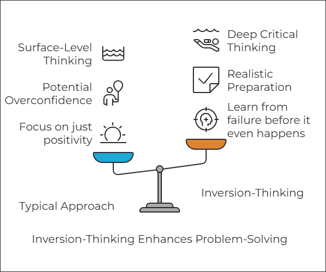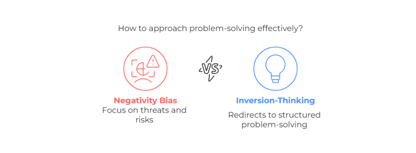Why Your Brain’s Negativity Isn’t a Flaw—It’s a Secret Weapon
Sara Klysing
2/24/20257 min read


When you think about personal growth, overcoming obstacles, and achieving success, it’s easy to focus on the positive—on what’s going right and how you can do more of that. But what about when things aren’t going to plan? How do you manage difficult situations or people without letting them drain your energy?
That’s where inversion-thinking comes in.
Why Your Brain Clings to Negativity
The human brain is hardwired to fixate on negative thoughts—a trait known as the “negativity bias.” This survival mechanism helped our ancestors prioritise threats like predators or food shortages, ensuring they stayed alive long enough to pass on their genes (Baumeister et al., 2001). While modern life rarely involves dodging sabre-toothed tigers, this bias still shapes how we process experiences: criticism stings more than praise lingers, and failures haunt us longer than successes.
Inversion-thinking leverages this ancient bias by redirecting it productively. Instead of fighting our instinct to dwell on risks, we channel it into structured problem-solving. By asking, “What could cause me to fail?” rather than “How can I succeed?” we work with our brain’s wiring, not against it.
The Power of Inversion-Thinking
Inversion-thinking is a powerful mental tool that shifts your perspective when tackling challenges. Instead of asking, “How can I succeed?”, flip the question: “What would cause me to fail?” This approach helps you identify potential pitfalls before they happen, so you can learn from them and make smarter choices.
Our brains are wired to focus on risks—it’s a survival instinct. Inversion-thinking harnesses this natural tendency by turning it into a structured way to solve problems. Instead of resisting your brain’s negativity bias, you work with it. Asking, “What could go wrong?” helps you gain clarity and transform uncertainty into action.
Applying Inversion-Thinking to Fitness Goals
Typical approach: “How can I work out four times a week?”
Inversion-thinking: “What would make me skip workouts?”
Potential obstacles: No time after work, boredom, lack of progress tracking.
Lessons learned: Shorter 20-minute sessions work better, variety keeps it fun, and tracking progress boosts motivation.
By recognising these patterns before they derail you, you create a plan that actually works—without relying on willpower.
A Real-Life Example: Healthier Habits
If you’re struggling to stay consistent with healthy habits, don’t just say, “I need to eat better and exercise more.” Instead, flip the perspective:
“What would make me unhealthy?”
Skipping meals → Learn that planning meals in advance prevents energy crashes.
Eating too much processed food → Discover that having healthy meals prepped makes better choices easier.
Staying sedentary → Realise that setting a daily step goal keeps you moving effortlessly, or even a 10-minute walk is better than nothing.
By understanding what leads to setbacks, you gain control over them—turning obstacles into stepping stones for success.
Why is Inversion-Thinking Useful?
Prevents Overconfidence Bias: Many people tend to be overly optimistic when planning for success, underestimating risks and challenges. Inversion thinking counteracts this bias by encouraging a realistic evaluation of potential obstacles, helping you prepare for the realities of the situation.
Encourages Critical Thinking: When you invert a problem, you force yourself to consider angles you might not have initially thought about. This deeper level of thinking often leads to more robust solutions and enhances your ability to overcome challenges.
Learn from Setbacks: Failure is an inevitable part of any journey and can provide the most powerful learning experiences. By identifying what could go wrong, you allow yourself to address those issues before they occur. This doesn't mean avoiding failure, but understanding it as an opportunity to grow, adjust, and improve.
Enhances Decision-Making: In both personal and professional settings, using inversion thinking can lead to more thoughtful and effective decisions. Rather than blindly pushing forward, you are empowered to make better-informed choices that increase your chances of success.
Inversion-thinking has also been championed by influential figures such as Charlie Munger and Alex Hormozi, who highlight its effectiveness in decision-making. The late Charlie Munger, former vice-chairman of Berkshire Hathaway, often emphasised the importance of avoiding mistakes rather than chasing perfect success (Munger, 2005). He believed that the best way to live is to focus on what not to do, rather than trying to find a foolproof plan for success.
Similarly, Alex Hormozi, entrepreneur and author of $100M Offers, applies inversion-thinking in business by first identifying all the possible reasons a venture could fail, then focusing on eliminating those risks (Hormozi, 2021). Both of these examples highlight how inversion-thinking leads to clearer decisions and more reliable results.
What Negative People Teach Us (Yes, Really!)
While chronic negativity can be exhausting, even pessimists offer hidden value. Here’s how to learn from them without absorbing their gloom:
Spot Risks Early: If a friend doubts your ability to stick to a new habit, they might be pointing out obstacles you haven’t considered—like time constraints or lack of motivation.
Refine Your Plans: Entrepreneur Elon Musk urges, “Take feedback from your most cynical friends—they’ll show you flaws you’re blind to.”
Build Resilience: Recent studies have demonstrated that teams incorporating a "devil's advocate"—a member who critically evaluates ideas—develop more resilient and adaptable strategies. For instance, research published in the MIT Sloan Management Review found that assigning a team member to challenge assumptions during meetings leads to better-considered next steps and reduces the need for follow-up discussions (Ogbonnaya et al., 2025).
Stay Grounded: A friend’s doubts about your business idea might push you to validate demand before investing.
The key?
Harness these insights without internalising the negativity.
Use inversion-thinking to extract lessons, then ditch the rest.
From Mars to Medicine: How Inversion Thinking Power Success
NASA’s Mars Rover: Engineers used Failure Mode and Effects Analysis (FMEA) to invert the question “How do we land safely?” to “What could make this rover crash?”
The result? Innovations like the “sky crane” landing system, which nailed the 2021 Mars touchdown (NASA, 2020).
Australian Healthcare System - Surgical Safety Checklists: Inspired by Atul Gawande’s The Checklist Manifesto, Australian hospitals adopted a surgical safety checklist to invert the question “How can we ensure patient safety during surgery?” to “What could harm a patient post-surgery?” This approach has been instrumental in reducing surgical complications and enhancing patient outcomes. For example, Western Australia's implementation of the Surgical Safety Checklist has led to a significant reduction in surgical complications by ensuring critical steps are followed, such as confirming patient identity and administering antibiotics (Health WA, 2023).
Putting It Into Practice
Negative Work Environment
Problem: A colleague constantly complains, making the workplace feel draining.
Inversion: “What would make me dread coming to work every day?”
Solution: Negative Conversations →
Limit time spent engaging in negative conversations.
Unproductive conversations → steer discussions toward solutions.
Negative people → surround yourself with more positive influences.
Social Burnout
Problem: A friend frequently vents about their problems but never takes action, leaving you emotionally exhausted.
Inversion: “What would make my social life feel overwhelming and draining?”
Solution: Always being the emotional dumping ground for others → Set boundaries on how much emotional energy you invest.
Never setting limits on venting sessions → Encourage conversations that include uplifting and balanced discussions.
Focusing only on problems without discussing solutions or positive topics → Gently steer your friend towards action rather than endless venting.
Procrastination Trap
Problem: You keep putting off a goal, feeling stuck in a cycle of overthinking.
Inversion: “What habits would guarantee I never start or finish this task?”
Solution: Constantly second-guessing every decision → Set a small, doable first step to create momentum.
Waiting for the “perfect” time or plan → Trust that clarity comes from action, not just thinking.
Overloading yourself with information instead of taking action → Focus on taking action and making progress, rather than achieving perfection.
Letting distractions take priority over the task → Remove distractions.
Counterarguments: The Limitations of Inversion Thinking
1. Paralysis by Analysis
It Can Lead to Paralysis by Analysis – Focusing too much on avoiding failure may result in over-cautiousness, preventing action and innovation. Sometimes, taking calculated risks is necessary for progress.
Fix: Set time limits for decision-making and prioritise the most critical risks instead of overanalysing every possibility.
2. Creativity Killer
Neglects Positive Creativity – By concentrating on what could go wrong, there is a risk of missing out on creative, forward-thinking solutions. Innovation often comes from exploring possibilities rather than just avoiding pitfalls.
Fix: Pair inversion thinking with a brainstorming session for positive solutions. After identifying what to avoid, shift focus to innovative strategies for success.
3. Pessimism Overload
May Reinforce a Negative Mindset – If overused, inversion thinking could lead to excessive pessimism, making people overly focused on problems rather than opportunities. A balanced approach is crucial.
Fix: Reframe inversion as a learning tool, not just a failure-prevention strategy. For every problem identified, also consider an opportunity it presents.
Final Takeaway: Your Brain’s Negativity is a Tool—Use It
Inversion-thinking isn’t about fearing failure—it’s about using it to sharpen your focus and drive forward. By embracing your brain’s natural negativity bias, you can turn obstacles into opportunities, uncover hidden risks, and make more informed decisions. Rather than trying to avoid mistakes, you learn from them and navigate towards success. As Winston Churchill wisely said, “Success is not final, failure is not fatal: It is the courage to continue that counts.” Harness the power of inversion-thinking to turn every setback into a stepping stone on your path to success.
References
Baumeister, R. F., et al., 2001. Bad Is Stronger Than Good. Review of General Psychology, 5(4), pp. 323–370.
Gawande, A., 2010. The Checklist Manifesto: How to Get Things Right. Picador.
Health WA, 2023. Surgical Safety Checklist – Western Australian Health Department. [online] Available at: [https://www.health.wa.gov.au](https://www.health.wa.gov.au/)
Hormozi, A., 2021. $100M Offers: How To Make Offers So Good People Feel Stupid Saying No. Acquisition.com.
Munger, C. T., 2005. Poor Charlie’s Almanack: The Wit and Wisdom of Charles T. Munger. Donning Company Publishers.
NASA, 2020. Mars 2021 Rover Mission: Landing Details. [online] Available at: [https://mars.nasa.gov/msl/mission/overview/](https://mars.nasa.gov/msl/mission/overview/)
Ogbonnaya, O., et al., 2025. The Role of Devil’s Advocates in Team Decision Making. MIT Sloan Management Review.




